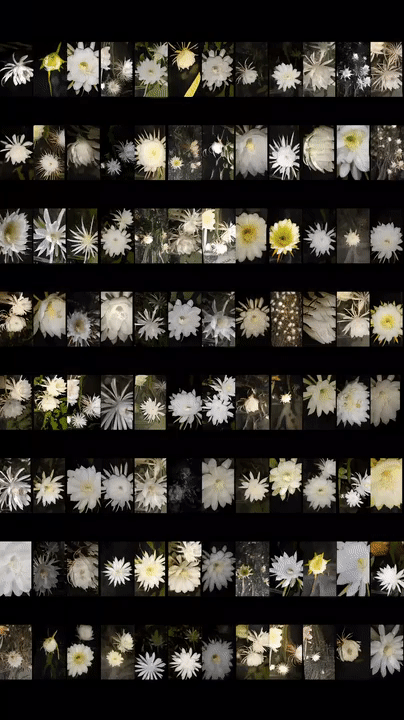N FTs and the idea of editioning art on the blockchain may be relatively new, but the artistic precedents of computer-generated art goes back to at least the 1960s. Vera Molnár started making artworks with plotters and computers back in 1968, and by 1972 the artist Harold Cohen had taught a computer named AARON to paint. And that’s to say nothing of the Conceptual theories that informed many of these artists — such as Sol LeWitt’s proposal that aesthetic parameters were what defined a work of art, and that they could be executed by anyone.
Sotheby’s auction “Natively Digital 1.3: Generative Art” digs into this storied history. The hybrid auction contains both NFTs and physical works, including seminal artworks by Molnár, Chuck Csuri and Roman Verostko — pioneers who helped define the field of generative art. The auction, which is open now through 25 April, 2022, was curated by Anne and Michael Spalter, Itzel Yard and Sofie Garcia, who represent generations of digital artists.
Below are just a few of the exciting works for sale. And for the latest on all things NFTs and digital art, join Sotheby’s Metaverse on Discord.
Charles Csuri’s Sine Curve Man (1967)
Charles Csuri’s pioneering work in computer art led to a series of advances as he experimented with everything from plotters to canvas and screen prints, numeric milling machine sculpture, holograms, animation and recently NFTs. One of Csuri’s most important images and a mainstay of historical accounts of computer art, Sine Curve Man is presented here as an NFT. The work, which references Cubist and Expressionist aesthetics, was the first artist-created figurative computer artwork, and arguably the first avatar.
Csuri is also represented in the auction with The Face of Change, an NFT that the artist digitally signed in 2021 shortly before he passed away in February this year.
Vera Molnár’s 1% de désordre (1% of disorder) (1976) and 2% of disorder in co-operation #01 (minted 2022)
Vera Molnár was one of the earliest artists to begin using a computer in her practice. Inspired by Piet Mondrian and Kazimir Malevich, Molnár made Constructivist computations before beginning to work with a plotter. 1% de désordre (1% of disorder) is one of Molnár’s earliest forays into plotter-based work, and it’s wonderfully emblematic of her art from this period, which is exhibited in “The Milk of Dreams,” the main show of this year’s Venice Biennale. This year, in celebration of her 98th birthday, Molnár revisited the work with 2% of disorder in co-operation #01, an NFT created through an innovative performative protocol.
Dmitri Cherniak’s The difference between the subtleties and the subtle ties (minted 2022)

Dmitri Cherniak’s work is directly inspired by the work of Vera Molnár, in addition to Piet Mondrian, Wassily Kandinsky and others. Best known for his “Ringers” series of computer-generated string-and-peg patterns, Cherniak is represented in this auction with both a single-edition NFT and a gicleé print. The image, titled The difference between the subtleties and the subtle ties, was made using a physics-based simulation of cell division.
Anna Ridler’s Anno oxypetalum (minted 2022)
Anna Ridler, listed as one of nine “pioneering artists” exploring AI’s creative potential by Artnet, has exhibited at the Victoria & Albert Museum, the Barbican Centre, Centre Pompidou and more. The artist’s work Anno oxypetalum (or “the year of the pointed petals”) is part of her larger interest in the chronobiology that dictates various plants’ movement throughout the day and night. The work itself is a kind of clock that represents the relationship between the natural world and standardized, digital timekeeping: Each flower in the image represents ten minutes, and each second represents approximately two days. The flowers move and sway with the light, which matches London beginning at the 2021 solstice — the day her daughter was born.
Anne Spalter’s The Wonder of it All (minted 2022)
Anne Spalter is a renowned digital mixed-media artist who founded the original digital fine arts courses at Brown University and the Rhode Island School of Design (RISD) in the 1990s. Inspired by Vera Molnár, her work combines digital and traditional media — during a residency at MASS MoCA, she painted images generated by neural networks. The Wonder of it All is Spalter’s most ambitious AI work to date. A tour-de-force of both technical and compositional drama, Spalter’s work takes the viewer on an epic sci-fi voyage through a fantastical AI-generated realm.
Be sure to check out other extraordinary works of digital art in “Natively Digital 1.3” before the auction closes on 25 April, 2022, and stay up to date by following Sotheby’s on Discord and Twitter.












![View 1 of Lot 12: [transmutation_of_species]](https://sothebys-com.brightspotcdn.com/dims4/default/4357d3c/2147483647/strip/true/crop/500x625+0+0/resize/301x376!/quality/90/?url=https%3A%2F%2Fsothebys-md.brightspotcdn.com%2Fdc%2Fe3%2Fc46b5b1c41b28b7a1e475544c335%2Fsofia-crespo-transmutation-of-species-tokengif2.gif)
